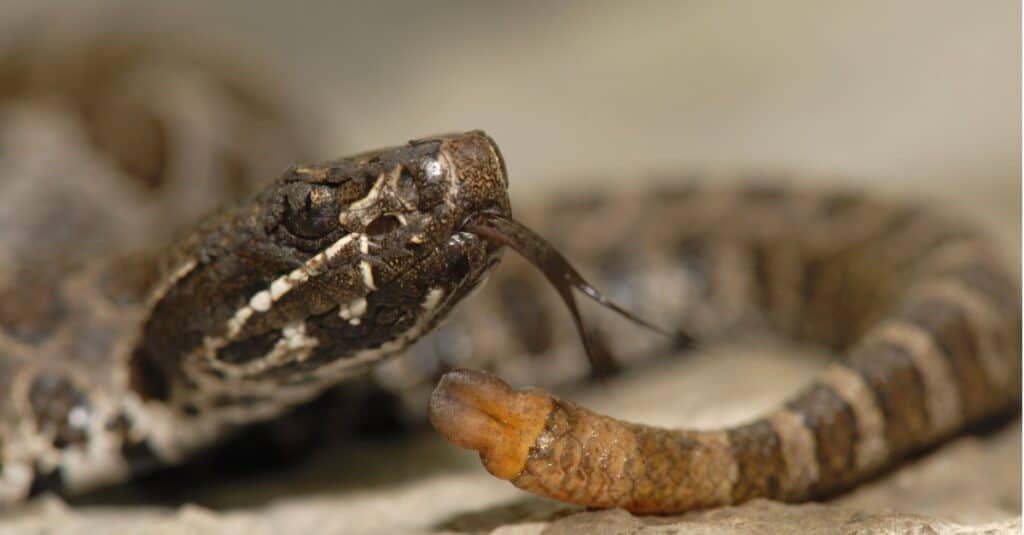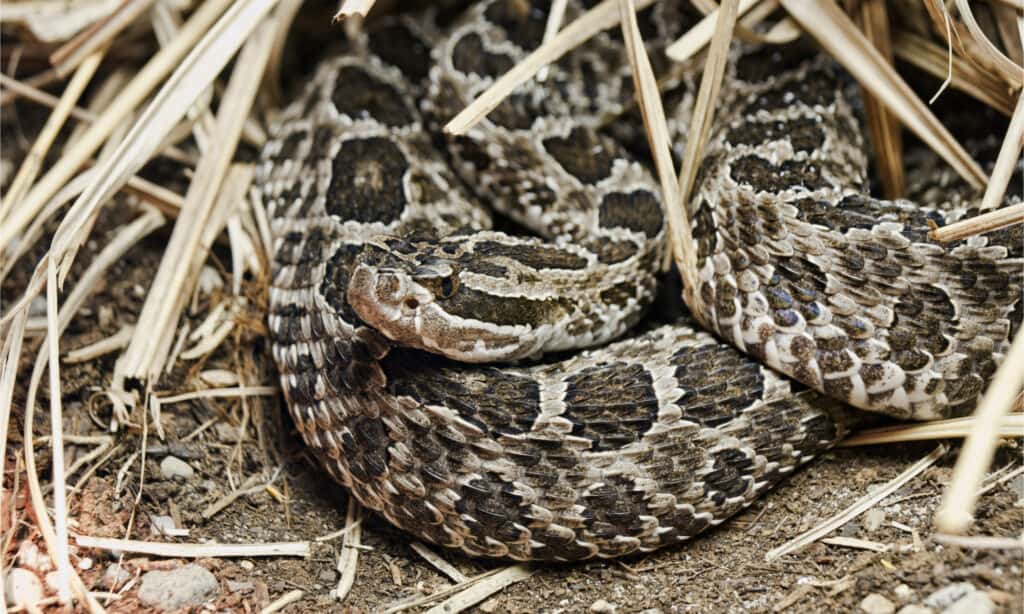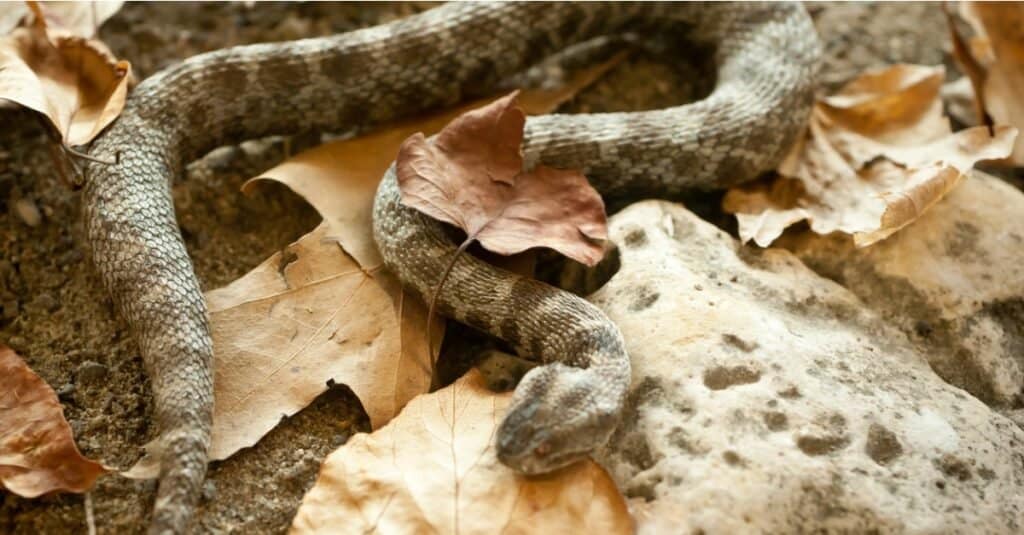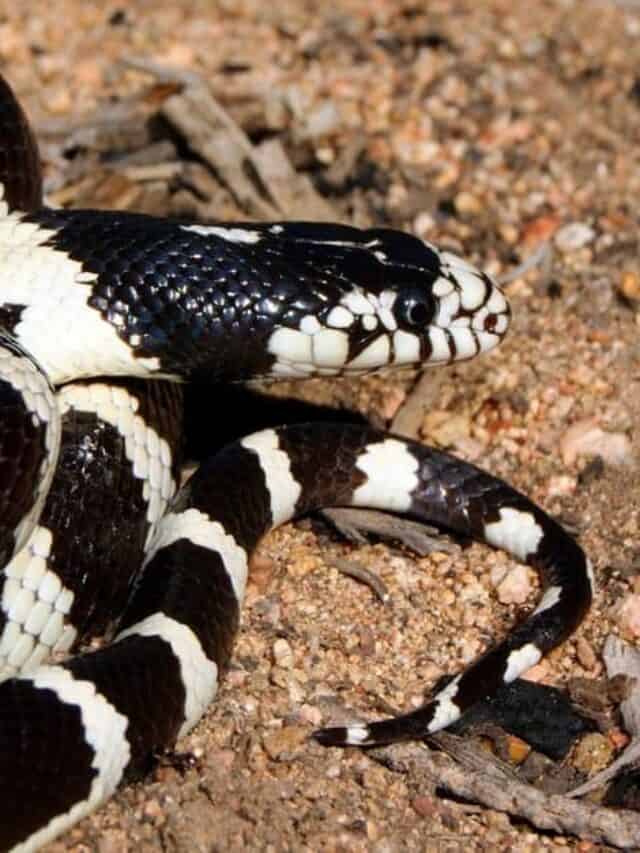The massasauga snake is a venomous pit viper. Its range spans from Southern Canada to Northern Mexico.
This rattlesnake belongs to the Viperidae family within three subspecies: the eastern massasauga, the western massasauga, and the desert massasauga.
While these snakes are venomous, they are not large. The average length of the massasauga snake and its subspecies is about 30 inches. But what is the largest size ever recorded for the massasauga snake? Let’s find out!
Largest Massasauga Snake Ever Recorded

The largest massasauga snake ever recorded was 34.75 inches.
©iStock.com/Shoemcfly
The largest massasauga snake ever recorded was a western massasauga that measured just under 35 inches. Officially, it was recorded at 34.75 inches in length. Massasauga snakes are one of the smaller species of rattlesnakes. They typically grow anywhere from 24 to 30 inches in length when they reach adulthood.
More About Massasauga Snakes
Subspecies and Locations

Eastern massasauga snakes live in many areas of the United States.
©Ryan M. Bolton/Shutterstock.com
Eastern Massasauga: The main subspecies that was identified as its own species in 2011 is the eastern massasauga. This species is commonly found in New York, Ohio, and Iowa. It can be spotted anywhere in the Northeast or North Midwest parts of the United States. It also resides in Ontario, Canada, along the shores of two of the Great Lakes.
Desert Massasauga: The desert massasauga resides in desert-like areas, such as Arizona, New Mexico, Texas, and certain parts of Mexico.
Western Massasauga: The western massasauga is common across the Midwest of the United States, such as Missouri, Kansas, and Oklahoma.
Appearance and Behavior

Massasauga snakes are typically light gray with dark brown patches.
©DnDavis/Shutterstock.com
While the appearance of the massasauga snake depends on its subspecies, the length, and heavy bodies are very similar. The eastern massasauga is usually a light tan color with brown patches. The western massasauga is quite similar, except it is usually light gray, and its patches or markings are dark brown. Marks are sometimes outlined in black.
Massasauga snakes have distinct, heart-shaped heads and vertical pupils. These snakes are typically nervous when approached by a predator. However, if they are provoked, they will rattle their tails in warning before striking and delivering a venomous bite.
Habitat

Massasauga snakes love to camouflage in the wetlands and grasslands that they inhabit.
©iStock.com/Westhoff
While massasauga snakes vary in location based on their subspecies, these snakes love to camouflage in wetlands and grasslands. Because they have heterothermic bodies, their body temperature varies according to the climate of their habitat.
During fall, they are common in wetlands. During the end of spring and the rest of summer, you will find them in drier areas. These snakes will often migrate from swamps and meadows to farms and grasslands whenever the weather and temperature shift.
Diet
Because massasauga snakes are the smallest species of rattlesnake, their prey is also on the smaller side. These snakes tend to eat small mammals such as rodents and other reptiles like lizards and frogs. While young massasauga snakes typically eat amphibians, adults primarily eat rodents. In states such as Michigan, these snakes eat frogs, even though they are not the main source of food. Massasauga snakes located in the northern and eastern populations eat frogs a lot more frequently.
When hunting prey, they strike and deliver a venomous bite, causing internal bleeding. After their venom disables their prey, they swallow it whole. The coolest thing about the Massasauga snake is the way it hunts. This snake lays in wait, using the heat-sensitive pits near its eyes to detect nearby prey, such as rodents.
Danger
Massasauga snakes are non-aggressive and will often flee when threatened. Often, when these snakes bite humans, it is because they are either provoked or stepped on. It is likely for them to be stepped on because they like to camouflage.
This is something that people need to look out for if they are planning to hike near rattlesnake territory. When bitten, the cytotoxic venom has properties that destroy tissue and disrupt blood flow. While this venom can kill small animals, it is unlikely to kill a human unless proper treatment is not sought.
Conclusion

Massasaugas have markings that include tan, gray, or brown with dark brown or black splotches.
©Rusty Dodson/Shutterstock.com
Sadly, the eastern massasauga is listed as an endangered species in many states due to habitat loss. Other factors such as climate change play a role in their decline as well.
In fact, during the late 1980s, studies then showed that the massasauga snake had nearly disappeared from its origin. The eastern massasauga has officially been classified as endangered throughout many states in the US.
You can do your part in helping conserve this snake species by joining the fight against climate change. Additionally, if you spot one, leave it alone. If you happen to come across a massasauga snake in the wild, allow it to flee without provoking it.
Gently back away and continue along a different path. This fascinating snake deserves its place in the wild. We can help by leaving it be and preserving the land it inhabits.
Other Record-Breaking Snakes

King snakes are listed on the IUCN Red List as Least Concern.
©Matt Jeppson/Shutterstock.com
One notable example of a large desert king snake was recorded in 2008 near Palm Springs, California. This individual measured almost seven feet in length and weighed nearly four pounds! While impressive in size alone, what makes this species truly remarkable is their ability to mimic venomous snakes such as rattlesnakes by hissing loudly and vibrating their tails when threatened.
While some may fear these creatures due to their resemblance to venomous snakes or simply because of their size, they are actually quite harmless to humans. In fact, they play an important role in controlling rodent populations throughout the deserts of North America where they reside.
Overall, while there are many record-breaking snakes out there with different traits that make them stand out from one another, the largest desert king snake ever recorded certainly holds its own place among them all.
The photo featured at the top of this post is © fivespots/Shutterstock.com
Discover the "Monster" Snake 5X Bigger than an Anaconda
Every day A-Z Animals sends out some of the most incredible facts in the world from our free newsletter. Want to discover the 10 most beautiful snakes in the world, a "snake island" where you're never more than 3 feet from danger, or a "monster" snake 5X larger than an anaconda? Then sign up right now and you'll start receiving our daily newsletter absolutely free.
Thank you for reading! Have some feedback for us? Contact the AZ Animals editorial team.






